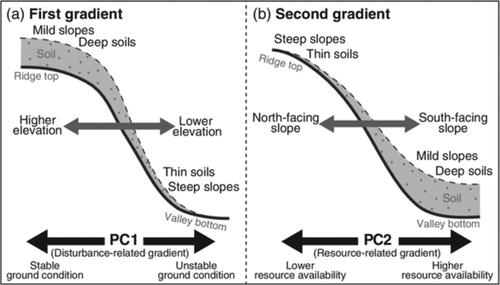当前位置:
X-MOL 学术
›
Ecol. Res.
›
论文详情
Our official English website, www.x-mol.net, welcomes your
feedback! (Note: you will need to create a separate account there.)
Phylogenetic signal in the topographic niche of trees: Current and historical significance of habitat structure on the species arrangement pattern within East Asian rugged forests
Ecological Research ( IF 1.7 ) Pub Date : 2020-05-22 , DOI: 10.1111/1440-1703.12110 Ryo Kitagawa 1, 2 , Makiko Mimura 3 , Akira S. Mori 2 , Akiko Sakai 2
Ecological Research ( IF 1.7 ) Pub Date : 2020-05-22 , DOI: 10.1111/1440-1703.12110 Ryo Kitagawa 1, 2 , Makiko Mimura 3 , Akira S. Mori 2 , Akiko Sakai 2
Affiliation

|
Topography often promotes habitat heterogeneity and is a major factor in fine‐grained changes in vegetation. Especially in temperate mountainous regions of East Asia, the distribution of tree species is largely explained by topographic niche differentiation. Because species niche is at least partially a historical product through the evolution of functional traits, phylogenetic signals are expected in the topographic arrangement pattern of species, although this has not been fully investigated. Thus, we examined common temperate trees in a 306 ha watershed on Mt Tanzawa, central Japan. The topographic niche position of each species was explained with two principal component analysis (PCA) axes, which aligned with the topographic structure of the watershed. High scores on PC1 reflected lower elevations, steeper slopes and nearby valleys. Higher scores on PC2 indicated thicker soil, more south‐facing slopes, slighter slope inclinations and nearby valleys. The former indicated the species were aligned on a habitat gradient of land‐surface instability, for which the gradient is typical under the current geological conditions. The latter indicated that a niche axis for resource availability relating to water, nutrients and light or heat existed. A phylogenetic signal, identified by Pagel's λ and the Mantel test, was detected for PC2 scores. However, the species arrangement along PC1 was independent of phylogeny. Our results suggested that the topographic niche of tree species in this area is caused by both relatively recently derived traits regarding adaptation to unstable land surfaces and conservative traits derived through plant evolution.
中文翻译:

树木地形生态位中的系统发生信号:东亚崎森林内生境结构对物种排列方式的当前和历史意义
地形通常会促进生境的异质性,并且是造成植被细粒度变化的主要因素。特别是在东亚的温带山区,树木种类的分布很大程度上是由地形生态位分化解释的。由于通过功能性状的进化,物种的生态位至少部分是历史产物,因此,尽管尚未进行充分的研究,但在物种的地形排列方式中预计会出现系统发生信号。因此,我们在日本中部丹泽山306公顷的分水岭上研究了普通的温带树木。用两个主成分分析(PCA)轴解释了每个物种的地形利基位置,该坐标与分水岭的地形结构对齐。PC1的高分反映了较低的海拔,更陡的坡度和附近的山谷。PC2上的分数越高,表示土壤越厚,朝南的斜坡越多,斜坡的倾斜度越小以及附近的山谷。前者表明该物种在陆地表面不稳定的栖息地梯度上排列,这种梯度在当前地质条件下是典型的。后者表明存在与水,养分,光或热有关的资源可利用性的利基轴。通过PC1分数检测到由Pagel的λ和Mantel测试确定的系统发生信号。但是,沿着PC1的物种排列与系统发育无关。我们的研究结果表明,该地区树种的地形利基是由相对较不稳定的地表适应性和植物进化而来的较保守性状引起的。更多的朝南斜坡,较小的斜坡倾斜度和附近的山谷。前者表明该物种在陆地表面不稳定的栖息地梯度上排列,这种梯度在当前地质条件下是典型的。后者表明存在与水,养分,光或热有关的资源可利用性的利基轴。通过PC1分数检测到由Pagel的λ和Mantel测试确定的系统发生信号。但是,沿着PC1的物种排列与系统发育无关。我们的研究结果表明,该地区树种的地形利基是由相对较不稳定的地表适应性和植物进化而来的较保守性状引起的。更多的朝南斜坡,较小的斜坡倾斜度和附近的山谷。前者表明该物种在陆地表面不稳定的栖息地梯度上排列,这种梯度在当前地质条件下是典型的。后者表明存在与水,养分,光或热有关的资源可利用性的利基轴。通过PC1分数检测到由Pagel的λ和Mantel测试确定的系统发生信号。但是,沿着PC1的物种排列与系统发育无关。我们的研究结果表明,该地区树种的地形利基是由相对较不稳定的地表适应性和植物进化而来的较保守性状引起的。前者表明该物种在陆地表面不稳定的栖息地梯度上排列,这种梯度在当前地质条件下是典型的。后者表明存在与水,养分,光或热有关的资源可利用性的利基轴。通过PC1分数检测到由Pagel的λ和Mantel测试确定的系统发生信号。但是,沿着PC1的物种排列与系统发育无关。我们的研究结果表明,该地区树种的地形利基是由相对较不稳定的地表适应性和植物进化而来的较保守性状引起的。前者表明该物种在陆地表面不稳定的栖息地梯度上排列,这种梯度在当前地质条件下是典型的。后者表明存在与水,养分,光或热有关的资源可利用性的利基轴。通过PC1分数检测到由Pagel的λ和Mantel测试确定的系统发生信号。但是,沿着PC1的物种排列与系统发育无关。我们的研究结果表明,该地区树种的地形利基是由相对较不稳定的地表适应性和植物进化而来的较保守性状引起的。后者表明存在与水,养分,光或热有关的资源可利用性的利基轴。通过PC1分数检测到了由Pagel的λ和Mantel测试确定的系统发育信号。但是,沿着PC1的物种排列与系统发育无关。我们的研究结果表明,该地区树种的地形利基是由相对较不稳定的地表适应性和植物进化而来的较保守性状引起的。后者表明存在与水,养分,光或热有关的资源可利用性的利基轴。通过PC1分数检测到由Pagel的λ和Mantel测试确定的系统发生信号。但是,沿着PC1的物种排列与系统发育无关。我们的研究结果表明,该地区树种的地形利基是由相对较不稳定的地表适应性和植物进化而来的较保守性状引起的。
更新日期:2020-07-28
中文翻译:

树木地形生态位中的系统发生信号:东亚崎森林内生境结构对物种排列方式的当前和历史意义
地形通常会促进生境的异质性,并且是造成植被细粒度变化的主要因素。特别是在东亚的温带山区,树木种类的分布很大程度上是由地形生态位分化解释的。由于通过功能性状的进化,物种的生态位至少部分是历史产物,因此,尽管尚未进行充分的研究,但在物种的地形排列方式中预计会出现系统发生信号。因此,我们在日本中部丹泽山306公顷的分水岭上研究了普通的温带树木。用两个主成分分析(PCA)轴解释了每个物种的地形利基位置,该坐标与分水岭的地形结构对齐。PC1的高分反映了较低的海拔,更陡的坡度和附近的山谷。PC2上的分数越高,表示土壤越厚,朝南的斜坡越多,斜坡的倾斜度越小以及附近的山谷。前者表明该物种在陆地表面不稳定的栖息地梯度上排列,这种梯度在当前地质条件下是典型的。后者表明存在与水,养分,光或热有关的资源可利用性的利基轴。通过PC1分数检测到由Pagel的λ和Mantel测试确定的系统发生信号。但是,沿着PC1的物种排列与系统发育无关。我们的研究结果表明,该地区树种的地形利基是由相对较不稳定的地表适应性和植物进化而来的较保守性状引起的。更多的朝南斜坡,较小的斜坡倾斜度和附近的山谷。前者表明该物种在陆地表面不稳定的栖息地梯度上排列,这种梯度在当前地质条件下是典型的。后者表明存在与水,养分,光或热有关的资源可利用性的利基轴。通过PC1分数检测到由Pagel的λ和Mantel测试确定的系统发生信号。但是,沿着PC1的物种排列与系统发育无关。我们的研究结果表明,该地区树种的地形利基是由相对较不稳定的地表适应性和植物进化而来的较保守性状引起的。更多的朝南斜坡,较小的斜坡倾斜度和附近的山谷。前者表明该物种在陆地表面不稳定的栖息地梯度上排列,这种梯度在当前地质条件下是典型的。后者表明存在与水,养分,光或热有关的资源可利用性的利基轴。通过PC1分数检测到由Pagel的λ和Mantel测试确定的系统发生信号。但是,沿着PC1的物种排列与系统发育无关。我们的研究结果表明,该地区树种的地形利基是由相对较不稳定的地表适应性和植物进化而来的较保守性状引起的。前者表明该物种在陆地表面不稳定的栖息地梯度上排列,这种梯度在当前地质条件下是典型的。后者表明存在与水,养分,光或热有关的资源可利用性的利基轴。通过PC1分数检测到由Pagel的λ和Mantel测试确定的系统发生信号。但是,沿着PC1的物种排列与系统发育无关。我们的研究结果表明,该地区树种的地形利基是由相对较不稳定的地表适应性和植物进化而来的较保守性状引起的。前者表明该物种在陆地表面不稳定的栖息地梯度上排列,这种梯度在当前地质条件下是典型的。后者表明存在与水,养分,光或热有关的资源可利用性的利基轴。通过PC1分数检测到由Pagel的λ和Mantel测试确定的系统发生信号。但是,沿着PC1的物种排列与系统发育无关。我们的研究结果表明,该地区树种的地形利基是由相对较不稳定的地表适应性和植物进化而来的较保守性状引起的。后者表明存在与水,养分,光或热有关的资源可利用性的利基轴。通过PC1分数检测到了由Pagel的λ和Mantel测试确定的系统发育信号。但是,沿着PC1的物种排列与系统发育无关。我们的研究结果表明,该地区树种的地形利基是由相对较不稳定的地表适应性和植物进化而来的较保守性状引起的。后者表明存在与水,养分,光或热有关的资源可利用性的利基轴。通过PC1分数检测到由Pagel的λ和Mantel测试确定的系统发生信号。但是,沿着PC1的物种排列与系统发育无关。我们的研究结果表明,该地区树种的地形利基是由相对较不稳定的地表适应性和植物进化而来的较保守性状引起的。











































 京公网安备 11010802027423号
京公网安备 11010802027423号